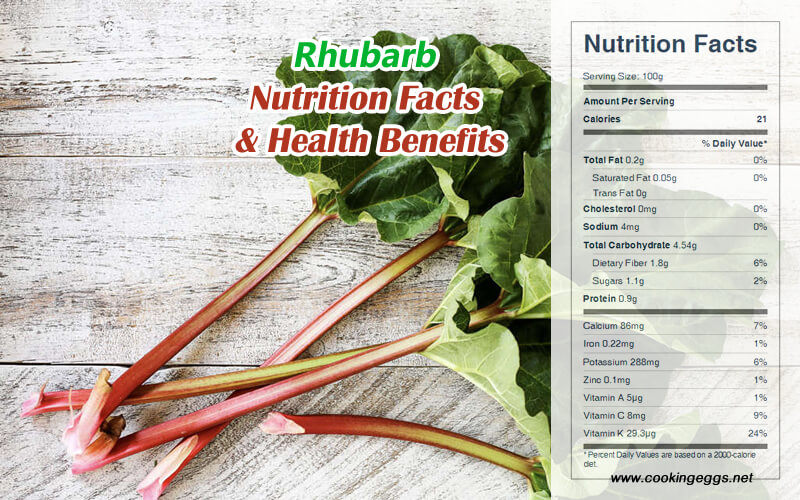Rhubarb Nutrition Facts & Health Benefits
Rhubarb is a winter-hardy herbaceous perennial grown for its edible fleshy stalks. It is often put to the same culinary uses as fruits. The leaf stalks can be used raw or most commonly cooked with sugar.
Nutritional value of Rhubarb
Raw rhubarb is 94% water, 5% carbohydrates, 1% protein, and contains negligible fat. Rhubarb is a good source of vitamin K, fiber, and calcium, and it also provides some potassium.
In a 100-gram reference amount, raw rhubarb supplies 21 calories of food energy and is a rich source of vitamin K (24% of the Daily Value), a moderate source of vitamin C (9% of the Daily Value), and contains no other micronutrients in significant amounts.
One cup of frozen raw rhubarb provides 29 calories, 7 g carbohydrate, and 0.8 g protein. 0.2 g fat, 2.5 g dietary fiber, 147 IU vitamin A, 7 mg vitamin C, 11 mcg folic acid, 148 mg potassium, 3 mg sodium, 266 mg calcium, 16 mg phosphorus, and 25 mg magnesium.

Raw Rhubarb Nutrition Facts Label
Health Benefits of Rhubarb
Rhubarb is very low in calories, and half of its carbohydrates are dietary fiber. Since it is very tart, rhubarb is usually sweetened with sugar when cooked. Its unusual flavor has led to its use in traditional medicine in many regions. It is known for its laxative effect, and the roots were initially cultivated for use as a purgative or cathartic.
More recently, researchers have been investigating rhubarb’s potential as a cancer-fighting food. Anthraquinones in rhubarb appear to attack cancer cells in several different ways, including starving tumor cells by interfering with their ability to take in glucose, limiting their proliferation and preventing metastasis (the traveling of cancer cells to other parts of the body).
Consuming vitamin K-rich foods helps to maintain healthy bones. Vitamin K is essential for bone growth and for repairing bone damage. It works together with minerals like calcium and vitamin D to achieve this. It is worth noting that getting vitamin K from natural sources such as rhubarb, as with other vitamins and minerals, is a better option than the synthetic alternatives.
Many studies suggest that rhubarb stems contain compounds that help control sudden sugar spikes without any adverse effects on overall health. Diabetic patients can add rhubarb to their daily meals to maintain normal glucose levels.
Rhubarb is very rich in vitamin K, besides other micronutrients and antioxidants, which can improve brain functions in a significant way. Vitamin K plays a vital role in the delivery of oxygen to brain cells. It also stimulates cognitive activity. Including rhubarb in your diet can, therefore, help support your brain health so that you retain good mental functions into old age.
Rhubarb is a powerful diuretic and it can play the role of maintaining properly functioning kidneys if it is consumed regularly. It helps your body to excrete various types of waste, toxins, excess minerals, and excess vitamins through increased urination. Also, according to some studies, rhubarb can help improve chronic renal failure.
Health Risk
Rhubarb damaged by a severe cold should not be eaten, as it may be high in oxalic acid, which migrates from the leaves and can cause illness.
Rhubarb leaves are toxic and should never be consumed. Do not confuse garden rhubarb with Chinese rhubarb, which is used as a potent purgative. Consume rhubarb in moderation. Due to its high content of oxalic acid, which can inhibit the absorption of calcium and iron, rhubarb is best avoided altogether by people suffering from arthritis, gout, kidney stones, and rheumatism.